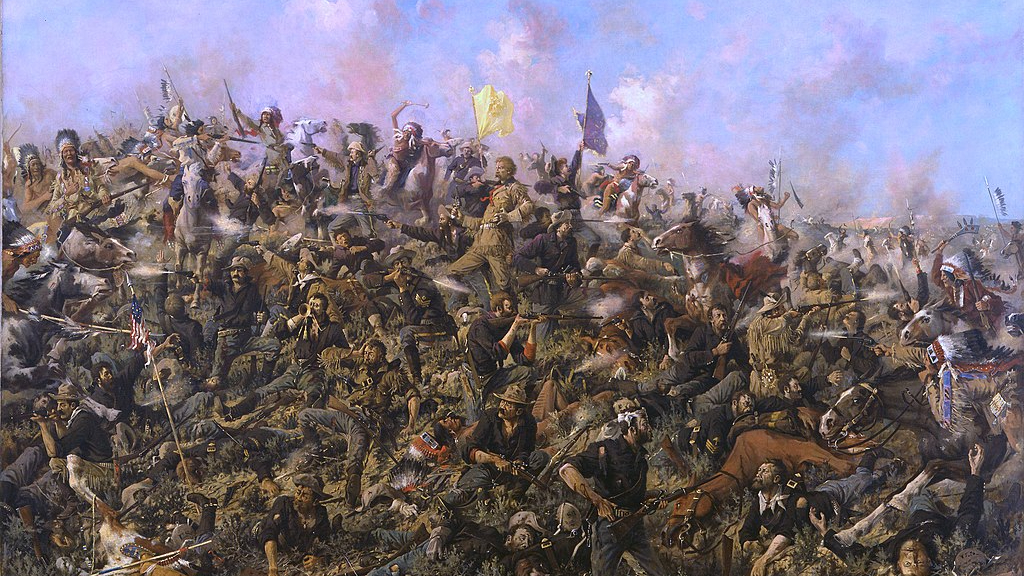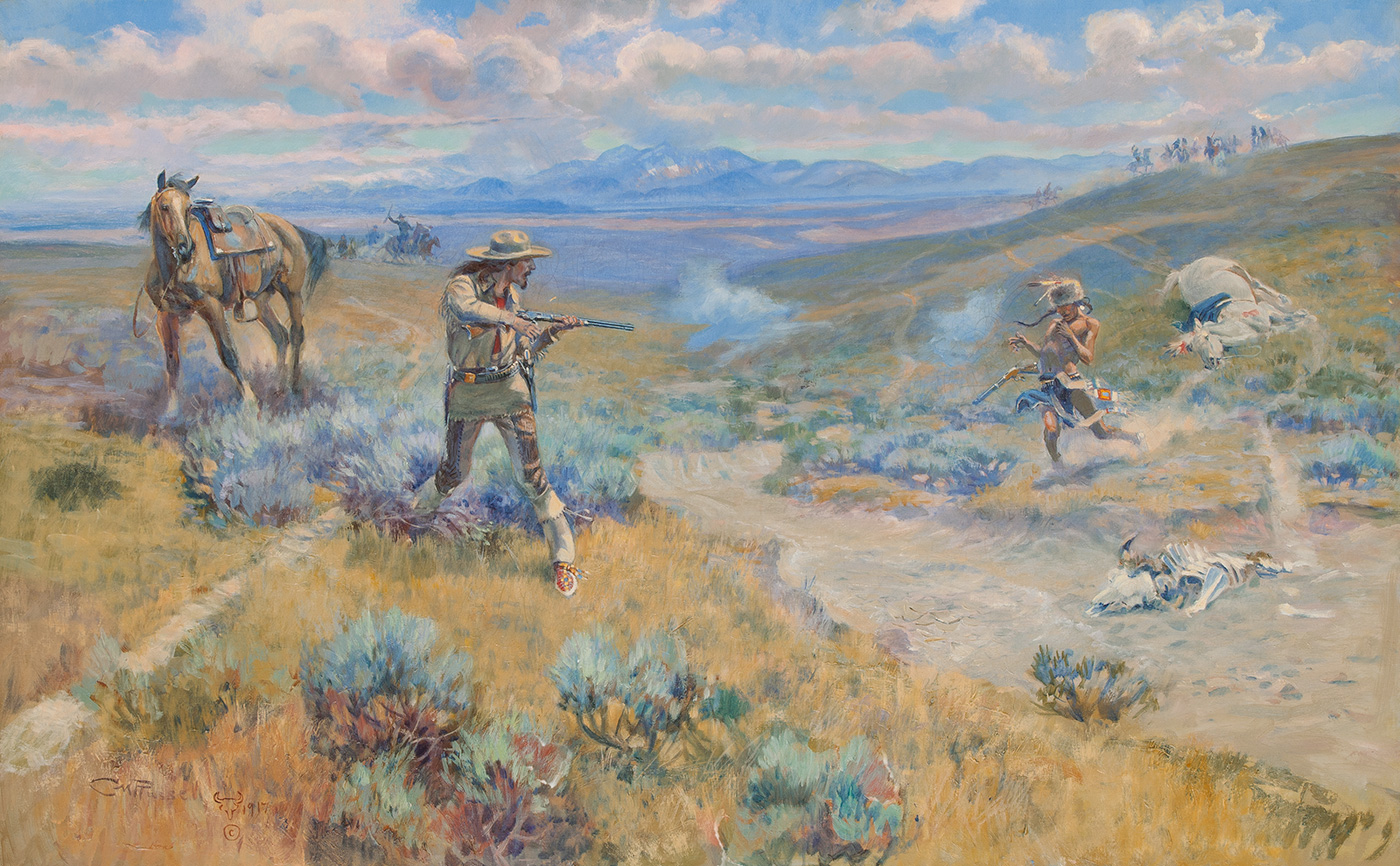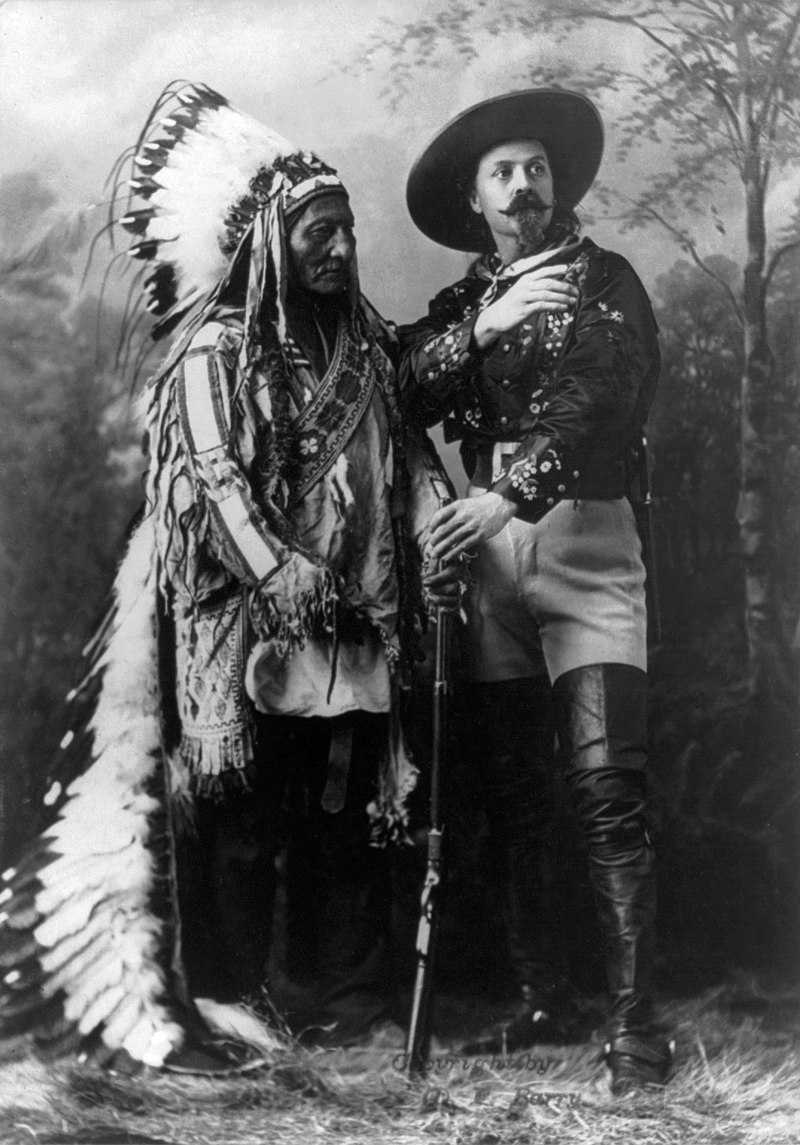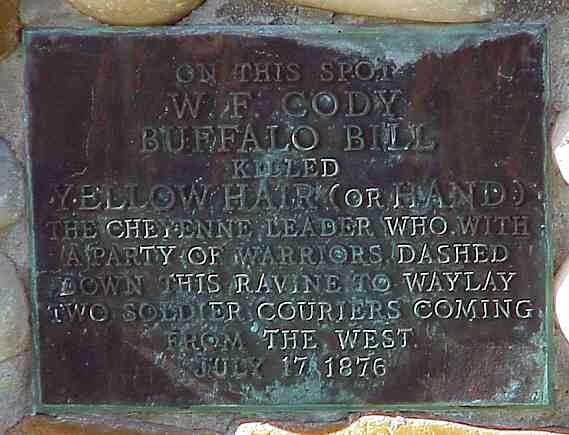William Cody established his reputation during a celebrated clash with Yellow Hair.
-
October 2022
Volume67Issue5
Editor’s Note: Steve Wiegard is the author of ten books, mostly on American history, and he was the longtime senior writer at the San Francisco Chronicle and San Diego Evening Tribune. He adapted the following essay from his most recent book, 1876 – Year of the Gun: The Year Bat, Wyatt, Custer, Jesse and the Two Bills (Buffalo and Wild) created the Wild West, and Why It’s Still With Us.

The plan was to ambush the ambushers. It was Will Cody’s idea. Col. Wesley Merritt, newly in command of the U.S. Army’s vaunted 5th Cavalry, approved it. Captain Charles King and trooper Chris Madsen watched it unfold from their vantage points on grassy knolls above the dry creek bed.
The war against the Plains tribes of Sioux and Cheyenne in 1876 had not been going well for the U.S. Army. There had been two major battles since the beginning of the year, and so far, the Army was 0-2. On June 17, a force of about 1,000 men led by Gen. George Crook had met an Indian force of about the same size led by the Lakota Sioux warrior Crazy Horse, at Rosebud Creek in southern Montana. While Crook later claimed victory, the reality was that he retreated after the battle to a base camp in Wyoming and licked his wounds for the next seven weeks.
Eight days after the Battle of the Rosebud, about 40 percent of Lt. Col. George Armstrong Custer’s 7th Cavalry was killed after encountering a much larger force of Lakota and Cheyenne at the Little Bighorn River, about 50 miles northwest of the Rosebud fight. Unlike Crook, Custer did not live to claim a “victory.”
Now it was just after dawn on July 17, in the grasslands and low undulating hills of what is today northwestern Nebraska. For more than seven weeks, the 330 or so members of the 5th Cavalry had been striving to find some Indians to fight. Instead, in the words of one officer, the regiment “was principally occupied in fighting flies.”
Rations were short; dust was thick; the sun roasted skin, and the occasional thunderstorm soaked to the bone. News of the Crook and Custer defeats, when it finally reached the 5th, further lowered morale. One officer was so rattled he faked a lung hemorrhage by inducing a nose bleed, swallowing the blood and then coughing it up. Regimental surgeons were not impressed, but his resignation was approved anyway.
The 5th had been cheered somewhat on June 9 by the appearance of a tall, long-haired 30-year-old fellow who had hurriedly left his previous job as a touring stage actor to become the regiment’s chief of scouts. Will Cody had scouted for the regiment seven years before in a successful campaign against Lakota and Cheyenne. He was well-liked and well-respected by the men of the 5th.
“There is very little change in his appearance since I saw him last in ’69,” a trooper wrote to a Kansas newspaper in late June, “except that he looks a little worn, probably caused by his (acting) vocation in the East not agreeing with him. All the old boys in the regiment, on seeing General (Eugene) Carr (whom Merritt relieved in early July) and Cody together, exchanged confidences, and expressed themselves to the effect that, with such a leader and scout, they could (handle) all the Sitting Bulls and Crazy Horses in the Sioux tribe.”
But if Cody looked much the same to the trooper-correspondent in late June, he sure didn’t on July 17. He showed up for work that morning wearing a red silk shirt with puffy sleeves, decorated with silver buttons. His trousers were black velvet, with a silver braid crisscrossing the thighs. He sported an extra-wide leather belt with a large silver buckle, and an oversized beaver-felt hat with a floppy brim. A colleague said he looked more like a fiesta-bound Mexican vaquero than a battle-bound U.S. Army scout.

Cody’s attire accomplished two things, whether he intended it to or not. The first was that it made him particularly conspicuous in any fight that might develop. This was a good way to ensure credit for his deeds on the battlefield – assuming it didn’t get him killed. The second thing was a shrewd career move. Assuming he lived, Cody could don his costume again when he resumed his stage performances, thereby adding an extra layer of authenticity by wearing the very clothes in which he had fought Indians.
But there had to be a fight for that to work, and on July 17, at a place now generally designated as Warbonnet Creek, there was a fight. Not a big fight, compared with Rosebud Creek or Little Bighorn, but still, a fight.
A few days before, Col. Merritt had received word that as many as 800 Cheyenne warriors from the Red Cloud Indian Agency, near Fort Robinson, Nebraska, were planning to leave the reservation and join the large group of Sioux and Cheyenne in Montana that had defeated Crook and Custer. The report was mostly true. A group of Cheyenne led by a chief named Dull Knife were headed toward the vast Indian assemblage that had whipped Crook and Custer. But the total was actually about 200, and that included women and children.
Merritt planned to cut them off, and the 5th rode most of the night to be in a position to do so. As the sun rose on the 17th, regimental lookouts spotted Indians on a ridge to the southeast. The warriors were apparently readying an attack on the regiment’s supply wagons, which had lagged slightly behind the mounted troops. The Cheyenne didn’t realize the rest of the regiment was waiting behind a line of low hills. Before Merritt’s trap could be sprung, however, two couriers from the supply wagons began riding toward the hidden troops. Seven of the Cheyenne began a stealthy approach toward the unsuspecting couriers.
What happened next would engender over the succeeding decades more exaggeration than a congressman’s resumé. One actual witness was Capt. Charles King, who had a remarkable pedigree. His great-grandfather helped draft the United States Constitution. His grandfather was a president of Columbia University. His father was a Union Army general and U.S. ambassador to the Papal States. In his own military career, he would serve not only in the Plains Indian Wars, but the Spanish-American and Philippine-American wars, and he trained troops in World War I, before retiring as a major general. King was also a prolific and successful writer, churning out more than 70 novels and memoirs.
In his 1890 book, Campaigning with Crook, and Stories of Army Life, King recalled Will Cody’s suggestion to Col. Merritt, as they watched the layers of planned ambushes unfold: “’By Jove!” says Buffalo Bill, ‘… now’s our chance. Let our party mount here out of sight, and we’ll cut those fellows off.’” Col. Merritt assented, ordering Cody and a half-dozen other scouts and troopers to wait until Capt. King gave the signal from his observation post. “Five seconds too soon,” King wrote, “and (the Indians) can wheel about and escape us; one second too late, and my blue-coated couriers are dead men.”
King evidently had pretty good timing. But his written observations from this point wander deep into hyperbole and melodrama. So, let’s turn instead to an account by trooper Chris Madsen, who watched from a lookout post through a field telescope. Like King’s, Madsen’s own biography was the stuff of novels. Born in Denmark, Madsen had fought in the Franco-Prussian War and professed to have belonged to the French Foreign Legion. He immigrated to America, and like many young male immigrants, joined the U.S. Army after being unable to find any other job. In later years, he would become a legendary U.S. deputy marshal in the Oklahoma Territory, and served with Teddy Roosevelt’s Rough Riders in the Spanish-American War.
In a 1938 letter to Cody’s most prominent early biographer, Don Russell, Madsen wrote that the two groups seemed to surprise each other. “Cody and the leading Indian appeared to be the only ones who did not become excited.”

The “leading Indian,” who was in his mid-20s, turned out to be the son of Cut Nose, a Cheyenne leader. The son’s name was Hay-O-Wei, which translated to Yellow Hair, but for years was mistranslated to Yellow Hand. His name referenced the fact that he carried with his battle gear a scalp that was thought, probably erroneously, to have belonged to a blonde woman. Like Cody, Yellow Hair was no slouch when it came to dressing up for war. In addition to a long, eagle-feathered headdress, he wore silver bracelets, beaded leggings, vermillion war paint and a breechcloth fashioned from a cotton American flag.
“The instant they were face to face, their guns fired,” Madsen recalled. “It seemed like almost one shot … Cody’s bullet went through the Indian’s leg and killed his pinto pony. The Indian’s bullet went wild. Cody’s horse stepped into a prairie dog hole and stumbled, but (Cody) was up in a moment. Kneeling, he took deliberate aim and fired the second shot. An instant before he fired the second shot, the Indian fired at him (again) but missed. Cody’s bullet went through the Indian’s head and ended the battle. Cody went over to the fallen Indian and neatly removed his scalp while the other soldiers gave chase to the Indian’s companions.”
As it turned out, Yellow Hair was the sole casualty on either side. Stunned by the presence of a cavalry regiment he had not detected, Dull Knife beat a hasty retreat back to the Red Cloud Agency. Merritt and the 5th followed them closely, but there was no more fighting. At the reservation, according to Cody’s sister, Yellow Hair’s father, Cut Nose, “offered Will four mules if he would return the war-bonnet and accoutrements worn by the young warrior and captured in the fight, but Will did not grant the request, much as he pitied Cut Nose in his grief.”
In fact, Cody had other plans for the scalp and other “trophies” he had collected. “We have had a fight,” he wrote to his wife Louisa the day after the skirmish. “I killed Yellow Hand, a Cheyenne chief, in a single-handed fight. You will no doubt hear of it through the papers.” To ensure the newspapers had it, Cody persuaded Capt. King to write up an account and send it to the New York Herald, which was owned by James Gordon Bennett, a good friend of Cody’s.
Cody sent Yellow Hair’s scalp – a hank of hair 15 inches long and still attached to a three-inch piece of skin – along with the warrior’s war bonnet, shield, bridle, whip, lance and other weapons, to a close pal, Moses Kerngood. A grateful Kerngood proudly displayed them in a window of his Pickwick Cigar Store in Rochester, New York. (At the time, Rochester was as close to a home town as Will Cody had.) The newspapers noted that “the scalp is not yet dry, but has been sprinkled with some chemical to preserve it.”
“I will write Kerngood to bring it (the scalp) up to the house so you can show it to the neighbors,” Cody told his wife (who later wrote that it smelled so bad, she almost fainted.) “I have only one scalp I can call my own, that fellow I fought single-handed in sight of our command, and the cheers that went up when he fell was deafening.” And if there was one thing for which Will Cody had an inordinate fondness, it was deafening cheers.

During his lifetime, William Frederick Cody appeared on stages, under tents and in arenas, before millions of people. But he never claimed to be an actor. “I’m a star,” he would explain. “All actors can become stars, but not all stars can become actors.”
He was being overly modest, a trait which he was seldom accused of having. Will Cody was a star. But he was also a brilliant actor. A bonafide hunter, guide, scout, and Indian fighter, he was also “Buffalo Bill,” a highly romanticized, outrageously exaggerated, and yet consistently believable version of himself - a character who somehow avoided becoming a caricature.
“Everybody has heard of ‘Buffalo Bill,’ the daring scout of the Plains,” a reporter wrote in September, 1876, “but William F. Cody is by no means so widely known, although they are one and the same person.” In Cody’s 1917 obituary, the New York Times noted that “it was not as an impersonator, but as himself, that Buffalo Bill delighted millions … and (became) the idol of generations of young boys the world over.”
More accurate than either “star” or “actor,” Cody was a showman. He seemed destined to it, through choice as well as fate. In his autobiography, he described his birth as his “debut” on the world’s stage. In her biography of him, Cody’s sister recounted a quite-possibly-apocryphal story about a young Will organizing his siblings into endless and elaborate settlers-versus-Indians games. “’I believe I’ll run a show when I get to be a man,’” she recalled him saying. When it was pointed out that a fortune teller had once predicted he would become president, Cody is said to have retorted “I’ll tell you right now, girls: I don’t propose to be president, but I do mean to have a show!”
He certainly looked the part of Wild West matinee idol. In his memoirs, Gen. Nelson Miles described Cody as “one of the handsomest men I have ever seen: very tall (6’1”) and straight; an abundance of golden brown hair falling to his shoulders, like a cavalier of old; brilliant brown eyes, auburn mustache and goatee, and features as perfect as if they had been chiseled out of marble.” The admiring wife of an Army officer remembered “his fine figure, as he stood by the sutler’s store, straight and slender, with his scarlet shirt belted in, and his long hair distinguishing him as the well-known character.”
The long hair could also be a distinguishing nuisance: Once, in a North Platte, Nebraska saloon, a bartender noticed Cody fussily trying to stuff his hair under his hat. When the barkeep asked why he didn’t just cut it off, Cody replied “if I did, I’d starve to death.”
But Cody was astute enough not to overplay the role of rough, uncouth frontier scout. Asked in 1871 by Gen. Philip Sheridan to guide a hunting party of military brass, newspaper editors, and Eastern businessmen on a hunting trip, Cody donned his buckskin coat and pants, crimson shirt, and oversized sombrero. But he dazzled the group even more by his demeanor. The generals and city slickers found Cody to be “a mild, agreeable, well-mannered man, quiet and retiring in his disposition, though well-informed and always ready to talk earnestly upon any subject of interest, and in all respects the reverse of the person we had expected to meet.”
And befitting a consummate showman, he was a prodigious liar. He frequently and adroitly blurred the line between his real deeds and heavily embroidered versions of them. He sometimes borrowed colorful events that had happened to others, and was not averse to trotting out several versions of the same story, depending on the audience. It was a habit to which he occasionally confessed.
“I am sorry to have to lie so outrageously in this yarn,” he once wrote to a publisher of one of the books he wrote. “My hero has killed more Indians on one war-trail than I have killed in all my life. But I understand what is expected in border tales. If you think the revolver and Bowie knife are used too frequently, you may cut out a fatal shot or stab wherever you deem it wise.”

He was exceedingly generous, to those he knew and those he didn’t. For most of his life, he was the main, or sole, support for both his immediate and extended family. He routinely handed out hundreds of free tickets to his shows to poor boys he met on the streets. Annie Oakley, the iconic female sharpshooter who for years starred in Cody’s Wild West shows, recalled a snowy night in New York City where she, Cody, and her husband, the sharpshooter Frank Butler, were on their way to dinner after a performance at Madison Square Garden. Business had been poor, and the trio had barely $30 among them. Outside the restaurant door, they encountered what Oakley described as “20 to 30 of the most tattered and hopeless mendicant down-and-outs I have ever seen anywhere.” Cody promptly pooled his money with Oakley’s and Butler’s, and gave a dollar each to the homeless men. “That left us just enough for frugal fare,” Oakley wrote, “… but that was Cody’s way.”
He was as careless with money, however, as he was generous. As one of his sisters put it, “financially, his shortcomings were deplorable.” He drove a hotel into insolvency by doling out free rooms and meals to the down and out. With a partner, he once built a town, called it Rome, and then watched it literally pick up and move to land he didn’t own so the townsfolk could be closer to a railroad line. And, despite making millions of dollars over his long show business career, he died with a relatively modest estate, in large part because of his over-fondness for flashy jewelry and shaky investments.
Another factor contributing to his lack of financial acumen was that he loved to have a good time. The colorful cowboy/author E.C. “Teddy Blue” Abbott recounted how Cody was once hired, at a handsome salary, by a group of Nebraska cattle ranchers to supervise a massive roundup. “Mostly, he raised hell,” Abbott wrote. “He had everyone running horse races and shooting at marks instead of gathering beef. He offered $100 to the first man who could rope a jack rabbit … pretty soon he sent to North Platte for more whiskey, and we did not do any more work for a week.” The cattle owners were not amused; Cody was fired.
He was, in some ways, dramatically inconsistent. A merciless slaughterer of thousands of buffalo, he became an ardent, though largely unsuccessful advocate of bison conservation. Having built a legend as a fearless Indian fighter and unhesitatingly portraying Native Americans as ludicrous stereotypes on stage, he became an outspoken defender of them as a people who had been severely wronged by European Americans and who were entitled to respect and fair treatment.
“Every individual’s character is a work in progress,” reads a placard at the Buffalo Bill Center of the West, in Cody, Wyoming. “William F. Cody’s was no exception. Paired opposites framed his character: rich vs. poor, success vs. failure, freedom vs. responsibility, vice vs. virtue, “untamed” West vs. “civilized” East. Throughout his life, he navigated between them, charting a course that would define his destiny.”

